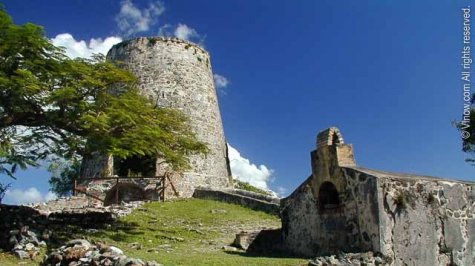Annaberg Plantation, as of 1780, was one of 25 active sugar producing factories on St. John. Other products produced at Annaberg were molasses and rum. Annaberg was named after William Gottschalk’s daughter and translates to Anna’s Hill. Gottschalk was the plantation owner. Slave labor was used to clear densely forested hillsides and to terrace the slopes around Annaberg to make farming possible. Slave labor was also used to plant, harvest and process the sugarcane. When slavery was abolished, plantations were divided. The 518 acres that were once Annaberg Plantation were divided into smaller farms.
Today the plantation ruins are protected by the Virgin Islands National Park and are open to the public. Trees have reclaimed the hillsides around Annaberg. A trail leads through factory ruins, slave quarters, windmill and other remains. Placards and signs along the trails describe how sugar was produced and discuss plantation life and the history behind sugar plantations on St. John and in particular Annaberg.
The windmill at Annaberg, one of focal points of the site, was built possibly between 1810 and 1830, and was one of the largest in the islands. Thirty four feet in diameter at the base and twenty feet at the top, the mill stands thirty eight feet high. When there was no wind to work the windmill, a horse mill would be used. The horses or mules were plodded in a circular motion; this turned the upright rollers in the center of the platform. Slaves passed cane stalk through the rollers and a box at the bottom caught the juice. The juice ran by gravity through gutters to the factory for processing. Three to five hundred gallons of juice could be produced in an hour.
The cane juice flowed first into a large copper kettle, where a fire was lit beneath. The excess water evaporated and workers would ladle the juice from one kettle to the next, down a line of five kettles. The juice eventually became concentrated through various levels of heating and evaporation. The concentrated juice was then placed in a box to crystallize. The crystallized brown sugar was then put in barrels that held up to 1,600 pounds of sugar. Early removal from the last heated kettle prevented crystals from forming however produced molasses that was used to make rum.
Some of the heating kettles used in the process described above are visible at Annaberg in the building photographed on the right.
Evidence of about 16 slave cabins were found in the Annaberg area. The construction of the cabins consisted of branches woven together with lime and a mud mixture. The roofs were likely made of palm leaves. The cabins deteriorated over time and are not fully standing; placards do indicate where the cabins were located and describe them.
We'd Love Your Feedback on Annaberg Plantation
Your review will not only provide candid feedback, but it will also help others make informed decisions when planning a Virgin Islands Vacation. Thanks, VInow.com
Views from Annaberg are fabulous/
-
{{#owner}}
-
{{#url}}
{{#avatarSrc}}
{{name}} {{/url}} {{^url}} {{#avatar}} {{& avatar}} {{/avatar}} {{name}} {{/url}} - {{/owner}} {{#created}}
- {{created}} {{/created}}




